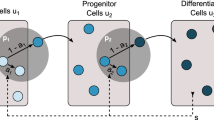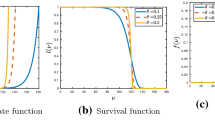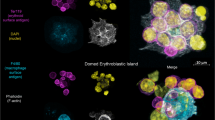Abstract
Many studies have shown that periodic erythrocytic (red blood cell linked) diseases are extremely rare in humans. To explain this observation, we develop here a simple model of erythropoiesis in mammals and investigate its stability in the parameter space. A bifurcation analysis enables us to sketch stability diagrams in the plane of key parameters. Contrary to some other mammal species such as rabbits, mice or dogs, we show that human-specific parameter values prevent periodic oscillations of red blood cells levels. In other words, human erythropoiesis seems to lie in a region of parameter space where oscillations exclusively concerning red blood cells cannot appear. Further mathematical analysis show that periodic oscillations of red blood cells levels are highly unusual and if exist, might only be due to an abnormally high erythrocytes destruction rate or to an abnormal hematopoietic stem cell commitment into the erythrocytic lineage. We also propose numerical results only for an improved version of our approach in order to give a more realistic but more complex approach of our problem.






Similar content being viewed by others
References
Adimy M, Crauste F (2007) Modelling and asymptotic stability of a growth factor-dependent stem cells dynamics model with distributed delay. Discrete Contin Dyn Syst Ser B 8(1):19–38. https://doi.org/10.3934/dcdsb.2007.8.19
Adimy M, Crauste F (2012) Delay differential equations and autonomous oscillations in hematopoietic stem cell dynamics modeling. Math Model Nat Phenom 7(6):1–22. https://doi.org/10.1051/mmnp/20127601
Adimy M, Crauste F, Ruan S (2005) Stability and Hopf bifurcation in a mathematical model of pluripotent stem cell dynamics. Nonlinear Anal Real World Appl 6(4):651–670. https://doi.org/10.1016/j.nonrwa.2004.12.010
Adimy M, Crauste F, Ruan S (2006) Modelling hematopoiesis mediated by growth factors with applications to periodic hematological diseases. Bull Math Biol 68(8):2321–2351. https://doi.org/10.1007/s11538-006-9121-9
Banks HT, Cole CE, Schlosser PM, Tran HT (2004) Modeling and optimal regulation of erythropoiesis subject to benzene intoxication. Math Biosci Eng 1(1):15–48. https://doi.org/10.3934/mbe.2004.1.15
Bélair J, Mackey MC, Mahaffy JM (1995) Age-structured and two-delay models for erythropoiesis. Math Biosci 128(1):317–346. https://doi.org/10.1016/0025-5564(94)00078-E
Beretta E, Kuang Y (2002) Geometric stability switch criteria in delay differential systems with delay dependent parameters. SIAM J Math Anal 33:1144–1165
Beutler E, Lichtman M, Coller B, Kipps T, Seligsohn U (2001) Williams hematology, sixth edn. No. vol. 487 in Williams Hematology, McGraw-Hill. https://books.google.fr/books?id=VoFNcAAACAAJ
Björkholm M, Holm G, Merk K (1982) Cyclic autoimmune hemolytic anemia as a presenting manifestation of splenic Hodgkins disease. Cancer 49(8):1702–1704
Boullu L, Pujo-Menjouet L, Bélair J (2019a) Stability analysis of an equation with two delays and application to the production of platelets. Discrete Contin Dyn Syst Ser S. https://doi.org/10.3934/dcdss.2020131
Boullu L, Pujo-Menjouet L, Wu J (2019b) A model for megakaryopoiesis with state-dependent delay. SIAM J Appl Math 79(4):1218–1243. https://doi.org/10.1137/18M1201020
Burwell EL, Brickley BA, Finch CA (1953) Erythrocyte life span in small animals comparison of two methods employing radioiron. Am J Physiol Legacy Content 172(3):718–724. https://doi.org/10.1152/ajplegacy.1953.172.3.718 (publisher: American Physiological Society)
Butina M (2020) 5—Erythrocyte production and destruction. In: Rodak’s Hematology, sixth edition edn, Elsevier, St. Louis (MO), pp 62–77. https://doi.org/10.1016/B978-0-323-53045-3.00014-3
Craig M, Humphries AR, Mackey MC (2016) A mathematical model of granulopoiesis incorporating the negative feedback dynamics and kinetics of G-CSF/neutrophil binding and internalization. Bull Math Biol 78(12):2304–2357. https://doi.org/10.1007/s11538-016-0179-8
Crauste F (2010) Stability and Hopf bifurcation for a first-order delay differential equation with distributed delay. In: Atay FM (ed) Complex Time-Delay Syst Theory Appl. Springer, Heidelberg, pp 263–296
Crauste F, Pujo-Menjouet L, Génieys S, Molina C, Gandrillon O (2008) Adding self-renewal in committed erythroid progenitors improves the biological relevance of a mathematical model of erythropoiesis. J Theor Biol 250(2):322–338. https://doi.org/10.1016/j.jtbi.2007.09.041
Dale DC, Hammond WP (1988) Cyclic neutropenia: a clinical review. Blood Rev 2(3):178–185. https://doi.org/10.1016/0268-960X(88)90023-9
Dinant HJ, Maat CEMd (1978) Erythropoiesis and mean red-cell lifespan in normal subjects and in patients with the anaemia of active rheumatoid arthritis. Br J Haematol 39(3):437–444. https://doi.org/10.1111/j.1365-2141.1978.tb01114.x
Doig K (2015) Erythrocyte production and destruction. In: Rodak’s hematology—clinical principles and applications, 5th edn, Elsevier Health Sciences, pp 95–111
Dou Y, Kruse A, Kotanko P, Rosen H, Levin NW, Thijssen S (2012) Red blood cell life span and erythropoietin resistance. Kidney Int 81(12):1275–1276. https://doi.org/10.1038/ki.2012.54
Erslev AJ (1997) Clinical erythrokinetics: a critical review. Blood Rev 11(3):160–167. https://doi.org/10.1016/S0268-960X(97)90011-4
Finch CA (1982) Erythropoiesis, erythropoietin, and iron. Blood 60(6):1241–1246. https://doi.org/10.1182/blood.V60.6.1241.1241
Finch CA, Deubelbeiss K, Cook JD, Eschbach JW, Harker LA, Funk DD, Marsaglia G, Hillman RS, Slichter S, Adamson JW, Ganzoni A, Biblett ER (1970) Ferrokinetics in man. Medicine 49(1):17–53. https://doi.org/10.1097/00005792-197001000-00002
Foley C, Mackey MC (2009) Dynamic hematological disease: a review. J Math Biol 58(1):285–322. https://doi.org/10.1007/s00285-008-0165-3
Fontenele LPS, Santucci R, Centrone R, Aranha MAF, Bellesso M, Dias DF (2015) Cyclic thrombocytopenia: a case report. Blood 126(23):4661. https://doi.org/10.1182/blood.V126.23.4661.4661
Fuertinger DH, Kappel F, Thijssen S, Levin NW, Kotanko P (2013) A model of erythropoiesis in adults with sufficient iron availability. J Math Biol 66(6):1209–1240. https://doi.org/10.1007/s00285-012-0530-0
Gibson CM, Gurney CW, Gaston EO, Simmons EL (1984) Cyclic erythropoiesis in the S1/S1d mouse. Exp Hematol 12(5):343–348
Gibson CM, Gurney CW, Simmons EL, Gaston EO (1985) Further studies on cyclic erythropoiesis in mice. Exp Hematol 13(9):855–860
Goodnough LT (2002) The role of iron in erythropoiesis in the absence and presence of erythropoietin therapy. Nephrol Dial Transplant 17(suppl\(_5\)):14–18. https://doi.org/10.1093/ndt/17.suppl_5.14
Gordon RR, Varadi S (1962) Congenital hypoplastic anaemia (pure red-cell anaemia) with periodic erythroblastopenia. The Lancet 279(7224):296–299. https://doi.org/10.1016/S0140-6736(62)91245-X
Greer JP, Foerster J, Lukens JN, Rodgers GM, Paraskevas F, Glader B (2003) Wintrobes clinical hematology, vol 1, 11th edn. Lippincott Williams & Wilkins, Philadelphia
Grover A, Mancini E, Moore S, Mead AJ, Atkinson D, Rasmussen KD, O’Carroll D, Jacobsen SEW, Nerlov C, (2014) Erythropoietin guides multipotent hematopoietic progenitor cells toward an erythroid fate. J Exp Med 211(2):181–188. https://doi.org/10.1084/jem.20131189
Gurney C, Simmons E, Gaston E (1981) Cyclic erythropoiesis in W/Wv mice following a single small dose of 89Sr. Exp Hematol 9(2):118–122
Haurie C, Dale DC, Mackey MC (1998) Cyclical neutropenia and other periodic hematological disorders: a review of mechanisms and mathematical models. Blood 92(8):2629–2640. https://doi.org/10.1182/blood.V92.8.2629
Hayes ND (1950) Roots of the transcendental equation associated with a certain difference-differential equation. J Lond Math Soc s1 25(3):226–232. https://doi.org/10.1112/jlms/s1-25.3.226
Jandl JH (1987) Blood: textbook of hematology. Lippincott Williams and Wilkins, Philadelphia
Koury MJ, Bondurant MC (1990) Erythropoietin retards DNA breakdown and prevents programmed death in erythroid progenitor cells. Science 248(4953):378–381. https://doi.org/10.1126/science.2326648
Krzyzanski W, Perez-Ruixo JJ, Vermeulen A (2008) Basic pharmacodynamic models for agents that alter the lifespan distribution of natural cells. J Pharmacokinet Pharmacodyn 35(3):349. https://doi.org/10.1007/s10928-008-9092-6
Langlois GP, Craig M, Humphries AR, Mackey MC, Mahaffy JM, Bélair J, Moulin T, Sinclair SR, Wang L (2017) Normal and pathological dynamics of platelets in humans. J Math Biol 75(6):1411–1462. https://doi.org/10.1007/s00285-017-1125-6
Lichtman M, Beutler E, Kipps Thomas J, M, Williams W, Kaushansky K, Kipps T, Seligsohn U, (2006) Williams hematology, seventh edition, 7th edn. McGraw-Hill medical publishing division, McGraw-Hill, New-York
Lodish H, Flygare J, Chou S (2010) From stem cell to erythroblast: regulation of red cell production at multiple levels by multiple hormones. IUBMB Life 62(7):492–496. https://doi.org/10.1002/iub.322
Loeffler M, Pantel K, Wulff H, Wichmann HE (1989) A mathematical model of erythropoiesis in mice and rats part 1: structure of the model. Cell Prolif 22(1):13–30. https://doi.org/10.1111/j.1365-2184.1989.tb00198.x
Ma J, Dou Y, Zhang H, Thijssen S, Williams S, Kuntsevich V, Ouellet G, Wong MMY, Persic V, Kruse A, Rosales L, Wang Y, Levin NW, Kotanko P (2017) Correlation between inflammatory biomarkers and red blood cell life span in chronic hemodialysis patients. BPU 43(1–3):200–205. https://doi.org/10.1159/000452728
Mackey MC (1978) Unified hypothesis for the origin of aplastic anemia and periodic hematopoiesis. Blood 51(5):941–956
Mackey MC (1979) Periodic auto-immune hemolytic anemia: an induced dynamical disease. Bltn Mathcal Biol 41(6):829–834. https://doi.org/10.1007/BF02462379
Mackey MC (1997) 8. Mathematical models of hematopoietic cell replication and control. In: Case studies in mathematical modeling-ecology, physiology and cell biology, New York, pp 151–182
Mackey MC (2001) Cell kinetic status of haematopoietic stem cells. Cell Prolif 34(2):71–83. https://doi.org/10.1046/j.1365-2184.2001.00195.x
Mackey MC, Glass L (1977) Oscillation and chaos in physiological control systems. Science 197(4300):287–289. https://doi.org/10.1126/science.267326
Mahaffy JM, Bélair J, Mackey MC (1998) Hematopoietic model with moving boundary condition and state dependent delay: applications in erythropoiesis. J Theor Biol 190(2):135–146. https://doi.org/10.1006/jtbi.1997.0537
Meyer RJ, Hoffman R, Zanjani ED (1978) Autoimmune hemolytic anemia and periodic pure red cell aplasia in systemic lupus erythematosus. Am J Med 65(2):342–345. https://doi.org/10.1016/0002-9343(78)90829-X
Morley A (1969) Blood-cell cycles in Polycythæmia vera. Australas Ann Med 18(2):124–126. https://doi.org/10.1111/imj.1969.18.2.124
Morley A (1979) Cyclic hemopoiesis and feedback control. Blood Cells 5(2):283–296
Morley A, Stohlman F (1969) Erythropoiesis in the dog: the periodic nature of the steady state. Science 165(3897):1025–1027. https://doi.org/10.1126/science.165.3897.1025 (Advancement of Science)
Morley A, Baikie A, Galton D (1967) Cyclic leucocytosis as evidence for retention of normal homoeostatic control in chronic granulocytic leukaemia. The Lancet 290(7530):1320–1323. https://doi.org/10.1016/S0140-6736(67)90910-5 (publisher: Elsevier)
Myssina S, Huber SM, Birka C, Lang PA, Lang KS, Friedrich B, Risler T, Wieder T, Lang F (2003) Inhibition of erythrocyte cation channels by erythropoietin. JASN 14(11):2750–2757. https://doi.org/10.1097/01.ASN.0000093253.42641.C1
Orr JS, Kirk J, Gray KG, Anderson JR (1968) A study of the interdependence of red cell and bone marrow stem cell populations. Br J Haematol 15(1):23–34. https://doi.org/10.1111/j.1365-2141.1968.tb01509.x
Pujo-Menjouet L (2016) Bood cell dynamics: half of a century of modelling. Math Model Nat Phenom 11(1):92–115. https://doi.org/10.1051/mmnp/201611106
Pujo-Menjouet L, Bernard S, Mackey MC (2005) Long period oscillations in a G model of hematopoietic stem cells. SIAM J Appl Dyn Syst 4(2):312–332. https://doi.org/10.1137/030600473
Ramakrishnan R, Cheung WK, Wacholtz MC, Minton N, Jusko WJ (2004) Pharmacokinetic and pharmacodynamic modeling of recombinant human erythropoietin after single and multiple doses in healthy volunteers. J Clin Pharmacol 44(9):991–1002. https://doi.org/10.1177/0091270004268411
Ranløv P, Videbæk A (1963) Cyclic haemolytic anaemia synchronous with Pel–Ebstein Fever in a case of Hodgkin disease. Acta Med Scand 174(5):583–588. https://doi.org/10.1111/j.0954-6820.1963.tb07957.x
Reimann HA (1971) Haemocytic periodicity and periodic disorders: periodic neutropenia, thrombocytopenia, lymphocytosis and anaemia. Postgrad Med J 47(549):504–510
Rogg S, Fuertinger DH, Volkwein S, Kappel F, Kotanko P (2019) Optimal EPO dosing in hemodialysis patients using a non-linear model predictive control approach. J Math Biol. https://doi.org/10.1007/s00285-019-01429-1
Sato Y, Mizuguchi T, Shigenaga S, Yoshikawa E, Chujo K, Minakuchi J, Kawashima S (2012) Shortened red blood cell lifespan is related to the dose of erythropoiesis-stimulating agents requirement in patients on hemodialysis. Ther Apher Dial 16(6):522–528. https://doi.org/10.1111/j.1744-9987.2012.01089.x
Shampine LF, Thompson S (2001) Solving DDEs in Matlab. Appl Numer Math 37(4):441–458. https://doi.org/10.1016/S0168-9274(00)00055-6
Singh R, Grinenko T, Ramasz B, Franke K, Lesche M, Dahl A, Gassmann M, Chavakis T, Henry I, Wielockx B (2018) Hematopoietic stem cells but not multipotent progenitors drive erythropoiesis during chronic erythroid stress in EPO transgenic mice. Stem Cell Rep 10(6):1908–1919. https://doi.org/10.1016/j.stemcr.2018.04.012
Woo S, Krzyzanski W, Jusko WJ (2006) Pharmacokinetic and pharmacodynamic modeling of recombinant human erythropoietin after intravenous and subcutaneous administration in rats. J Pharmacol Exp Ther 319(3):1297–1306. https://doi.org/10.1124/jpet.106.111377
Wu H, Klingmüller U, Besmer P, Lodish HF (1995) Interaction of the erythropoietin and stem-cell-factor receptors. Nature 377(6546):242–246. https://doi.org/10.1038/377242a0
Acknowledgements
We are very thankful to Michael C. Mackey for his highly valuable feedback, comments and spelling corrections.
Author information
Authors and Affiliations
Corresponding author
Additional information
Publisher's Note
Springer Nature remains neutral with regard to jurisdictional claims in published maps and institutional affiliations.
Appendices
Appendix 1: Sufficient Stability Condition
In this “Appendix”, we use the theorem established by Hayes (1950) to formulate a sufficient stability condition for the equilibrium \(E^*\). Consider a set of model parameters A, \(\delta _{me}\), q, \(\beta \), \(K_c\), \(\alpha \), \(\delta _e\) and \(\tau \). If \(\tau = 0\) then the characteristic equation (12) admits a unique root \(\uplambda = - \delta _e - L\) which is real and negative because \(L > 0\). Now, we consider that \(\tau >0\). Eq. (12) can be written as
The latter equation is adapted to the theorem formulated by Hayes (1950). Hence, if \(\uplambda \in {\mathbb {C}}\) verifies Eq. (23) then
Which can also be written as
Given that \( 0< -\cos (\mu ) < 1\) holds for all \(\mu \in \left( \frac{\pi }{2}\, , \, \pi \right) \), we obtain Proposition 2.
Appendix 2: Continuity, Differentiability and Variations with Respect to Model Parameters
Derivatives with respect to E. Given the form of \(K(\cdot )\) in Eq. (2), trivial derivation rules and simple computations lead, for \(E > 0\), to
and
Continuity and variations with respect to \(\tau \). Remembering the fact that L is strictly positive for all \(\tau \ge 0\), one can establish from the implicit function theorem that, all other parameters being fixed, \(\tau \mapsto E^*(\tau )\) is continuously differentiable on \([0,+\infty )\) and
\(\tau \mapsto E^*(\tau )\) is thus a strictly decreasing function with \(\lim \limits _{\tau \rightarrow \infty }E^*(\tau )=0\). After few lines of computations not mentioned here, one also obtains
This expression enables us to study the variation of L with respect to \(\tau \). From
we establish that if model parameters are such that Condition (14) holds then \(\tau \mapsto L(\tau )\) admits a unique maximum at
and
Continuity and variations with respect to \(\delta _e\). Remembering the fact L is strictly positive for all \(\delta _e >0\), one can establish that \(\delta _e \mapsto E^*(\delta _e)\) is continuously differentiable on \((0,+\infty )\) and
\(\delta _e \mapsto E^*(\delta _e)\) is thus a strictly decreasing ranging from \(+\infty \) (when \(\delta _e\rightarrow 0\)) to 0. One also obtains
We establish after a few tedious computations that the function \(\delta _e \mapsto L(\delta _e)\) admits a unique maximum
with
Continuity and variations with respect to \(K_c\). As previously done, one can establish that the function \(K_c \mapsto E^*(K_c)\) is continuously differentiable and
The equilibrium \(E^*\) is thus a strictly increasing function of \(K_c\) and we have. One subsequently conclude, by composition, that \(K_c \mapsto L(K_c)\) is continuously differentiable on \({\mathbb {R}}_+\), all other model parameters being fixed. With computations similar to the one performed by the reader in the latter paragraph, few lines of computations, not mentioned here, leads to
From this expression, one can study the variation of L with respect to \(K_c\). Using Eq. (9), one sees that
and easily establish that if the sufficient condition (13) holds, then \(K_c \mapsto L(K_c)\) admits a maximum at
given by
Continuity and variations with respect to \(\delta _{me}\). Similarly to the previous paragraphs, we have that \(\delta _{me} \mapsto E^*(\delta _{me})\) is continuously differentiable and
Then, \(\delta _{me} \mapsto E^*(\delta _{me})\) is a strictly decreasing with \(\lim \limits _{\delta _{me} \rightarrow \infty }E^*(\delta _{me})=0\). Similarly, one also obtains
With the same arguments previously mentioned, if Condition (14) is satisfied then \(\delta _{me} \mapsto L(\delta _{me})\) admits a maximum
at
Appendix 3: Proof of Proposition 7
Let \(\psi \) be one of the parameter among \(\delta _e\), \(K_c\), \(\delta _{me}\) or \(\tau \). First, let us remark that 0 is a root of Eq. (12) if and only if \(\delta _e = -L (\psi )\). Yet, we know that \(L (\psi )>0\). Consequently, 0 cannot be a root Eq. (12).
Moreover, considering the complex conjugate of Eq. (12), we obtain that if \(\uplambda \in i{\mathbb {R}}\) is a root of Eq. (12) then \( -\uplambda \) is also a root of this equation. From this, we know that if pure imaginary roots of Eq. (12) exist, then they will be given by \(\uplambda = \pm \mathrm {i} \omega (\psi )\), \(\omega (\psi )>0\).
Let \(\psi ^*\in {\mathcal {P}}\) be a chosen parameter. Thanks to Proposition 2 and to Corollary 1, we know that if \(\psi ^* \notin \varPi \) then pure imaginary roots of Eq. (12) cannot exist. It is thus necessary that \(\psi ^* \in \varPi \).
We begin to show the first part of Proposition 7. From what we just mentioned above, we assume, without loss of generality, that \(\mathrm {i}\omega (\psi ^*)\), \(\omega (\psi ^*) >0\), is a root of Eq. (12). In such situation, separating the real from the imaginary part, we obtain that \(\omega (\psi ^*)\) must verify
Considering that \(-1 \le \cos (x) \le 1\) and that \(\delta _e > 0\), we verify that \(\psi ^*\in \varPi \) is a necessary condition for the definition of System (24). The latter system also reads
and we obtain
Consequently,
and we get that \(\omega (\psi ^*)\) is expressed by Eq. (16).
Remark 4
It is necessary that \(\psi ^*\in \varPi \) otherwise \(\omega (\psi ^*)\) is not defined. This condition also guarantee, a posteriori, that the function \(\psi \mapsto \omega (\psi )\) is well defined on the set \(\varPi \).
Finally, from the signs involved in Eq. (24), it is necessary that
from which it follows that there exists \(k\in {\mathbb {N}}\) such that \(\psi ^* \in \varPi \) verifies
We reformulate the latter condition using the function z defined in Eq. (17) and obtain the first part of Proposition 7: if \(\mathrm {i}\omega (\psi ^*)\) for \(\psi ^*\in \varPi \) is a root of (12) then there exists \(k\in {\mathbb {N}}\) such that \(\psi ^*\in \varPi \) is a zero of \(z(\cdot ,k)\).
Remark 5
For all \(k \in {\mathbb {N}}\), \(\psi \mapsto z(\psi ,k)\) is well defined and continuously differentiable on \(\varPi \).
The proof of this remark directly originates from the continuous differentiability of \(\psi \mapsto L(\psi )\) and \(\psi \mapsto \omega (\psi )\) on \(\varPi \).
The reciprocal of Proposition 7 is simply established by separating real and imaginary parts and by doing similar computations to the one above. The proof of the end of this proposition is given by Beretta and Kuang (2002).
Rights and permissions
About this article
Cite this article
Adimy, M., Babin, L. & Pujo-Menjouet, L. Why Are Periodic Erythrocytic Diseases so Rare in Humans?. Bull Math Biol 84, 19 (2022). https://doi.org/10.1007/s11538-021-00973-6
Received:
Accepted:
Published:
DOI: https://doi.org/10.1007/s11538-021-00973-6
Keywords
- Erythropoiesis
- Periodic hematological diseases
- Dynamic diseases
- Delay differential equations
- Hopf bifurcation




